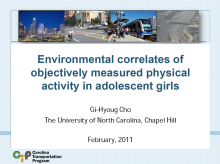We are pleased to announce an exciting new alliance between Active Living Research and GP RED to co-host and coordinate...
Environmental Correlates of Objectively Measured Physical Activity in Adolescent Girls

Presentation at the 2011 Active Living Research Annual Conference
Out and About: Association of the Built Environment with Physical Activity Behaviors of Adolescent Females
DA Rodriguez, G-H Cho, KR Evenson, TL Conway, DA Cohen, B Ghosh-Dastidar, JL Pickrel, S Veblen-Mortenson, & LA Lytle
DOWNLOAD: Full article
Background:
While the literature linking neighborhood characteristics to physical activity has grown, the emergence of portable GPS units allows further examination of where activity occurs. Recent studies using GPS and accelerometers concurrently suggest that bouts of physical activity are more likely to occur in areas with environmental supports. To date, limited research among youth has examined the objectively assessed built environment context within which physical activity occurs.
Objectives:
To examine associations between the built environment and light, moderate, and vigorous physical activity as measured with passive, portable accelerometer and GPS units among adolescent girls.
Methods:
The Trial of Activity for Adolescent Girls-2 (TAAG2) Study is a longitudinal observational study of physical activity and nutrition behaviors of adolescent girls in San Diego, CA and suburban Minneapolis/St. Paul, MN. Participants were part of the control condition of the original TAAG Study. In TAAG2 each participant was measured twice, half began in 10th grade and were measured again in 11th grade, while the other half began in 11th grade and were re-measured in 12th grade. Only the 265 participants who had valid data both times were included in this analysis.
Participants wore a Foretrex 201 portable GPS unit and an ActiGraph 7164 accelerometer for one week at both time points. Using customized Java software, GPS and accelerometer data were merged so that each GPS point had a corresponding accelerometer count. Thus, each GPS point contains information about the intensity of physical activity associated with the accelerometer counts. Because GPS units record locations when in view of satellites, the points recorded could be considered “outdoor behaviors”. However, to avoid misclassifying behaviors that occurred while inside home or school, any point falling within a school property or within 60 meters (200ft) of a participant’s home was excluded from analysis.
The rich, spatially-explicit dataset allows for in-depth analyses of contextual information by using each GPS point, as opposed to a participant, as a unit of analysis. This minute-by-minute analysis of GPS and physical activity data patterns has been shown to be a promising way of identifying environmental influences on physical activity in youth8. In this analysis, the outcome variable is each point’s physical activity intensity classified using counts as sedentary (=100, =3000, =5200 counts/min).
The built environment within a 200-meter (1/8-mile) circle of each GPS-accelerometer point was measured by calculating: population density (from the US Census Bureau), street density (from TIGER 2009 files), and the presence of parks, schools, physical activity facilities, food outlets, and fast food restaurants collected from county and municipal sources by the original TAAG study. Data on food outlets and fast food restaurant locations for San Diego were provided by the NIK study9. In Minneapolis/St. Paul, food-related data was taken from city and county health department inspection records. In both sites, park and food-related data were updated with direct observations for select city areas.
Multinomial logistic regression was used to investigate associations while accounting for the clustering of points within each participant using robust standard errors. Other control variables included the study site and whether the point belonged to measures taken in 10th, 11th, or 12th grade for each participant. Multi-level models accounting for the clustering around schools will be estimated for the full paper.
Results:
A total of 9002 moderate or vigorous points, 72721 light, and 154757 sedentary intensity points were identified over 1994 person-days of observation. Light and sedentary points were randomly sampled (9000 points each) to achieve equal shares with the moderate and vigorous points identified. Of these, 68% had full built environment data (64% sedentary, 66% light, and 76% moderate or vigorous) and were used for analysis.
Having a park and lower population density within the 200-meter circle of each point were positively associated with light and vigorous physical activity, relative to sedentary activity. The presence of schools within the buffer was positively associated with light and moderate physical activity, while physical activity facilities were associated only with light activity, both relative to sedentary activity. The presence of fast food restaurants was associated with light physical activity, but not with moderate or vigorous activity, as compared to sedentary. The presence of food outlets was positively associated with light activity, but negatively associated with moderate or vigorous activity, while higher street density was positively associated with moderate activity but negatively associated with vigorous activity, all relative to sedentary behavior.
Conclusions:
In this sample of adolescent girls, moderate physical activity was higher in places with higher street density and near schools, while vigorous activity was higher near parks and areas with low population density. Moderate and vigorous physical activity was higher in places with lower density and fewer food outlets. Efforts to increase physical activity may benefit from attention to parks and school surroundings. Researchers should consider separate examinations of the built environment and activity for different levels of physical activity intensities.
Support:
NIH/NHLBI # R01HL71244
STAY UP TO DATE
RECENTLY ADDED TOOLS & RESOURCES
MOVE! A BLOG ABOUT ACTIVE LIVING
The "Active Living Conference" aims to break down research and practice silos and...







